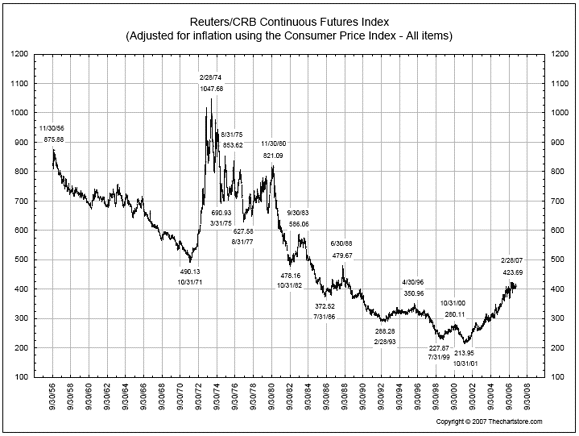 Summer Sale Summer Sale
Puru Saxena
13 July 2007
We are witnessing a generational
bull-market in all types of natural resources (energy, food and
metals). This boom in commodities is largely due to supply and
demand imbalances plus the ongoing monetary inflation which is
adding fuel to the fire.
Today, the various central
banks continue to pump money and credit into the system and combined
with the rising per-capita consumption levels in Asia and Latin
America, you can begin to understand why the prices of commodities
are at record-highs.
For sure, this sector has already
risen considerably in this bull-market, however I suspect that
the uptrend will continue for several more years. Firstly, back
in 2001, natural resources were the cheapest they had ever been
in the history of capitalism, so this advance has commenced from
a very depressed level. Secondly, when adjusted for inflation
(even via the bogus official CPI data which understates the inflation
menace), commodities remain extremely cheap (Figure 1).
Figure 1: Is this
a bubble?
 Source: www.thechartstore.com
Source: www.thechartstore.com
These days, some analysts are
claiming that this bull-market in commodities is solely due to
monetary inflation and that supply and demand imbalances have
no influence whatsoever. I tend to disagree with their assessment
because constant monetary inflation has been our reality since
the early 1970's when gold was removed from the monetary system
YET the prices of commodities (energy, food and metals) declined
significantly between 1980 and 2001. So, it is clear that the
debasement of currencies alone is not responsible for the ongoing
surge in the prices of commodities.
In order to have a lasting
bull-market in any sector, supply and demand must be out of whack.
In the case of natural resources today, demand is rising ferociously
in China and India whilst supply is struggling. Consider the
energy market as an example: At the beginning of this decade,
China and India combined used to consume roughly 8% of the world's
oil and today they consume over 11%. Now, to illustrate my point
that supply and demand are important factors, I would add that
this rising demand (regardless of monetary inflation) would not
have translated into a higher oil price IF there was an endless
supply of oil. In the current scenario however, the oil price
is rising because supplies are extremely tight when compared
to demand. In fact, I would argue that humanity is staring "Peak
Oil" in its face.
Today the average Chinese consumes
less that 2 barrels of oil per year and the average Indian consumes
less than a barrel of oil per year whereas the average American
consumes 25 barrels per year. After reviewing this data, you
don't have to be a rocket-scientist to figure out that demand
for energy in Asia can only rise in the future. And unless we
can find a way to increase supply, the price of oil will continue
to appreciate.
If you have invested in commodities,
you will be thrilled to learn that apart from energy, the inventory
levels of other resources such as base-metals or food are also
extremely depleted. And these stock-piles are low due to the
sudden and unexpected surge in demand brought about by the rapid
industrialisation and urbanisation of China, India and parts
of Latin America. A growing percentage of the three billion people
in the "emerging" economies are now putting immense
pressure on the planet's resources as consumers and the scramble
to find more commodities is on. Exploration activity, whether
for metals or energy, is at multi-year highs and I suspect that
billions of dollars will be spent in the years ahead as nations
desperately look for additional resources to feed demand.
It is interesting to note that
after the brutal correction in commodities last year, energy,
food and base-metals have recovered, however the precious metals
have failed to rally. Moreover, if you compare the performance
of the various commodities over the past 5 years, you will realise
that industrial commodities (base metals and energy) have outperformed
the precious metals by a wide margin. This was expected as the
economic activity has been very strong recently and gold is a
counter-cyclical asset. No doubt, it has been frustrating for
investors to watch their gold holdings drift lower for a year.
Despite the recent underperformance, I continue to believe that
gold is also in a gigantic bull-market which has a long way to
run.
You must understand that in
the case of base-metals (copper, lead, zinc, nickel and tin),
changes in industrial demand and physical supply cause prices
to rise or fall. However, when it comes to gold, investment
demand alone is the single most important factor that can make
or break a bull-market. And the investment demand for gold is
directly linked to the public's inflation expectations.
If the masses are worried about
future inflation, they tend to convert their cash to gold as
a store of value. On the other hand, when the public is calm
about inflation, the reverse takes place.
Banks are in the business of
lending paper currencies so it is absolutely vital for their
survival that the public's confidence in the monetary system
remains high and that inflation expectations remain under control.
Every central banker knows that if the public really understood
the inflation problem, the monetary system would come under strain.
So far, the central banks have done a fabulous job of managing
the public's inflation expectations. However, I am of the opinion
that this is about to change. As soon as the public realises
that inflation is much higher than the official CPI data, we
could see a stampede towards gold.
Recently, precious metals have
drifted lower which is typical at this time of the year. In
fact, the wonderful summer sale in on! Remember, corrections
during a bull-market are opportunities rather than a problem.
Once this consolidation is complete this summer, I expect precious
metals to soar towards the end of this year.
In summary, I believe that
every investor should take advantage of this correction in metals
and allocate a meaningful portion of their net-worth to the resources
sector. Rather than buying the physical commodities through
index-tracker funds (due to the negative impact of contango),
I suggest investors allocate their hard-earned capital to resource-producing
companies which in this raging bull-market are still trading
at bear-market valuations!
Puru Saxena
 Saxena Archives Saxena Archives
email: puru@purusaxena.com
website: www.purusaxena.com Puru Saxena publishes Money Matters, a monthly economic report, which highlights extraordinary investment opportunities in all major markets. In addition to the monthly report, subscribers also receive "Weekly Updates" covering the recent market action. Money Matters is available by subscription from www.purusaxena.com. Puru Saxena is the founder of Puru Saxena Wealth Management, his Hong Kong based firm which manages investment portfolios for individuals and corporate clients. He is a highly showcased investment manager and a regular guest on CNN, BBC World, CNBC, Bloomberg, NDTV and various radio programs. Copyright ©2005-2015 Puru Saxena Limited. All rights reserved.
Recent Gold/Silver/$$$ essays at 321gold:
Jan 02 Silver: Book Trading Position Profits Morris Hubbartt 321gold
Jan 02 Gold Reckoning Looms Adam Hamilton 321gold
Jan 01 FYI New Year's Day Holiday Market Schedule 321gold
Dec 30 White Gold: Plans for a Big 2026 Bob Moriarty 321gold
Dec 30 A Wild Metals Market But Is It A Top? Stewart Thomson 321gold
Dec 29 L@@K Amazon Kindle and Paperback Books by... Bob Moriarty 321gold
|
321gold Ltd

|

 Summer Sale
Summer Sale
